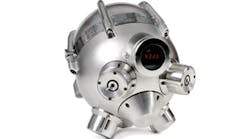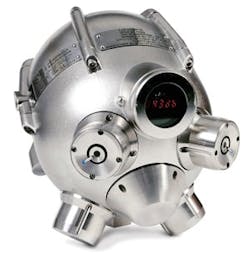Check Out Montague's Google+ profile.
Sometimes sound is better than sight—just ask any bug-hunting bat, submarine sonar operator or air-traffic controller. They all know that seeing requires a narrowly focused visual field, while hearing can take in audio data from a wide radius all around.One example of this capability on display at this week's Emerson Global Users Exchange is Emerson Process Management's new Incus ultrasonic gas leak detector, which can provide immediate warnings of toxic, asphyxiating or combustible gas leaks and other conditions and greatly improve on the limited performance and scope of optic-beam, infrared and other traditional sensing methods. Instead, Incus detects the sound generated by high-pressure gas releases over as much as a 40-meter radius. Most importantly, Incus' immediate detection and alerts can give on-site staff time to put on masks and perform other safety measures.
Factory-calibrated for life with sensors that never expire, Incus is intrinsically safe (IS) and explosion-proof. Emerson reports that Incus isn't designed to replace point-detection and other traditional sensors, but to help supplement them. The unit already has had success in Europe and some Asia/Pacific markets and is now being launched in North America.
Read Also: Emerson's Intrinsically Safe CHARMs
Named for the diminutive, anvil-shaped bone in the human ear, Emerson's new Incus gas leak detector can pinpoint the sound of a gas leak up to 40 meters away.
This environmental sensing and monitoring system is just three years old, but it's based on acoustic detection principles that have been evolving and refined for 15 years. Early versions of Incus were built by Grovely Detection and Net Safety Monitoring, which was acquired by Emerson about two years ago."Because oil and gas applications in the North Sea must report all hydrocarbon releases on offshore platforms, engineers began trying to use microphones to find leaks in 1998," says Dr. Eliot Sizeland, global sales and marketing director for Emerson's Ultrasonic Gas Leak Detection Division.
"Research showed that a lot of releases weren't being found or reported by traditional optic, catalytic or point-detection methods, so developers began trying to plug that gap with audible and then ultrasonic technologies."
To detect leaks over such wide areas, Incus uses four multidirectional, acoustic sensing heads, and its 4-20 mA signals are enabled by relays and HART protocol communications. It even uses an on-board, user-programmed microprocessor to help determine when a gas leak is identified. While it's not self-determining, this microprocessor employs user-defined parameters to decide if a release has occurred. Users can also set up time delays and use stepped outputs of its 4-20 mA signals to arrange for alarms via its relay contacts.
"We're using piezoelectric resonance sensors on all four sensing heads, and they allow Incus to detect much smaller releases and lower leak sources or respond to gas flows over much broader areas," explained Sizeland. "Competing devices only use microphones with diaphragms, which move and respond to temperature changes, so they must be repeatedly calibrated. So for the same size release, Incus achieves four to five times greater area coverage."








